
Print, Victor Ancheta, 2003.
July 18 is the 383th anniversary of the arrival of the Virgin of Antipolo to the Philippines from Mexico. To commemorate this date, here's a reprint of a century old editorial, detailing the icon's history. The article originally appeared in the Manila American back in 1904.

Canonical Coronation of the Virgin of Antipolo,
Photo courtesy of Alex Castro.
OUR LADY OF PEACE AND PROSPEROUS VOYAGES
November 27, 1904
At a distance of about fourteen miles from Manila to the East is situated the delightful and picturesque town of Antipolo at an elevation of 285 metres.
The town with its 600 houses or more is built on a small plateau which opens toward the North. The church, famous throughout the Islands, occupies the highest part in the East, and from it a view, not to be excelled in any part of the globe, is obtained. The plain and city of Manila, with its numerous suburbs, Cavite province, the vast fields of Bulacan and Pampanga and far away on the horizon the mountain range of Zambales, Mariveles, the entrances to the bay and the heights of Sungay and Pico de Loro; and, coming from Taytay, about one mile distant, the panorama of Laguna de Bay, the great lake, spreads out before the traveler's eyes, its southern boundary showing those three unsurpassable mountains, Cristobal, Banajao and Banajao de Lucban.
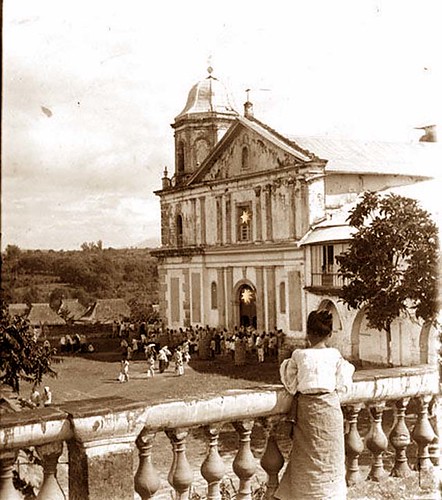
Old Antipolo Church.
Antipolo, like most all of the towns of Morong and Laguna, owes its existence to the untiring zeal of the great and noble Franciscan Friars, whose entire existence is consecrated to the good of humanity, and who, as early as 1578, evangelized, civilized, and gathered into towns, villages and hamlets the savage natives of these provinces.
But the great and well-merited fame enjoyed by Antipolo is not so much due to its benign climate, picturesque location and health-restoring springs as to an image of ' Our Lady of the Angels,' guarded in its church and venerated to the utmost confines of the archipelago, and even beyond it, under the name of ' Our Lady of Peace and Prosperous Voyages,' and to which Governor Don Sebastian Hurtado de Corcuero gave, in 1639 or 1640, the title of Protectress and Admiral of the Fleet.
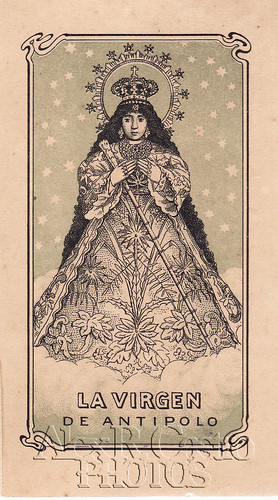
A Recuerdo from 1904.
Courtesy of Alex Castro.
This holy image of the Blessed Virgin, like so many numerous other benefits, the Philippines owe to their old metropolis, the vice-kingdom of New Spain, Mexico, the fairest country on earth. When Don Juan Nino de Tavora, a Galician nobleman and knight of Calatrava, appointed captain-general of this archipelago, arrived on his way to Manila at enchanted Acapulco, the mountain-enclosed seaport of the Aztec empire, he said his prayers and heard his Mass in the parish church of that jewel of the Pacific. Struck with admiration by an image of the Holy Virgin, its serene aspect and above all its indescribably beautiful eyes, full of love and triumph, he spared no means to acquire it for his new capital, Manila.
On March 25, 1626, the image of Our Lady was transferred with great pomp and ceremony aboard the galleon; the next day, March 20th, she set out on her long voyage, and the ship bearing the precious burden cast anchor on July 18th of the same year in Cavite. Great was the rejoicing when the happy news of her arrival became' known, and all vied with each other to do honor to the ' Virgen Americana.' A solemn and splendid procession, headed by the highest functionaries, civil and ecclesiastic, all the nobility, gentry, troops and an enormous concourse of natives, accompanied the representative of one of the divinest and purest cults of Catholicism to the Cathedral.
Shortly afterward the Virgin took up her abode in Antipolo, where she remained without interruption until the end of 1639. In 1639 the Chinese and Chinese mestizos arose in revolt against the constituted authorities, committing outrages and ravages without name, applying the torch to the hamlets and towns, destroying plantations and putting all who fell into their hands to the sword without distinction of sex or age. The savage horde also assaulted Antipolo and after a heroic resistance on the part of brave natives, who fought like lions, took it. Soon the flames kindled by the rebels did their work and Antipolo had ceased to exist. The church was only a heap of ashes and burned timbers, enclosed by bare walls, but in this shapeless mass the image of the Blessed Virgin and a wooden cross were found absolutely intact and perfect by the Spaniards and Indians.

The Virgin of Antipolo, lanced by the Chinese Rebels.

The Virgin, thrown into the flames by the Chinese, was found unharmed by the Spanish military.
Photos courtesy of Alex Castro.
The Madonna having been proclaimed Patroness and even Admiral of the Fleet, her statue was repeatedly carried over sea. Three or four times it visited its ancient shrine in Mexico. Alonzo Garcia commanded the galleon ' San Luis,' which bore the Blessed American Virgin in 1641 on her first visit home to the rich shores of Mexico, and with him she returned after a happy voyage to these Islands. Again in 1643, the same vessel set sail for the country of the Holtecs and Aztecs, with General Lorenzo de Ugalde Orella serving as knight to the Virgin of the Philippines, who now set out for the realm over which the Virgin of Tecoac, ' La Guadalupana ' reigns supreme over all hearts and minds.
The good ship ' Encarnacion ' left Cavite in 1645, with the Virgin of Antipolo as its admiral, and after a prosperous voyage returned laden with troops, treasure and merchandise, to the Pearl of the Orient, Manila.
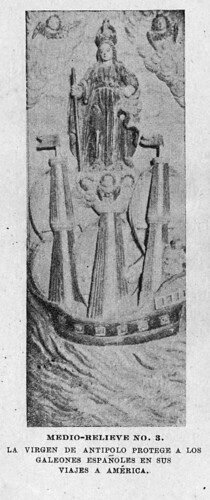
The Virgin of Antipolo protecting the Spanish Galleons with their travels to America.
Photo courtesy of Alex Castro.
The galleon 'San Francisco Javier' took the celestial Patroness for the fourth time in 1651 to her beloved Acapulco, and there among the palms and fragrant blossoms of her own land she remained .until 1653. Having, as always, guided the vessel entrusted to her care safely back to Manila, on September 9, 1653, the Virgin of Peace and Prosperous Voyages, as she was named at about that time, set out to take up her former abode in the mountain recess of Antipolo. Indescribable was the joy with which her children welcomed their mother and well beloved. She was received with acclamations wherever she passed, and after a journey of twelve days, having been detained by the fervent inhabitants of Taytay nine days, Our Lady made her triumphant entry into Antipolo.

Photo courtesy of Alex Castro.
After her return she remained for eighty-five years undisturbed in the beautiful home which love and faith had built for her far away from the world's noise, traffic, hypocrisy and misery. Still her services as Patroness and Admiral of the Fleet were yet necessary. In June, 1746, borne by the faithful in procession, she was taken to Manila, and towards the middle of the same month installed as commander of the flagship ' Nuestra Senora del Pilar ' with which she sailed for the evergreen shores of Mexico.
A pious tradition says that the glories won by Don Andres Lopez de Azaldigui, with an inferior force and vessels, off Cavite, over twelve Dutch ships-of-battle on June 13, 1647, was due to the intercession of the Virgin of Antipolo. In this sea fight the Spaniards only lost one of their countrymen and fifteen Filipinos, but the Dutch suffered heavily in dead and wounded.
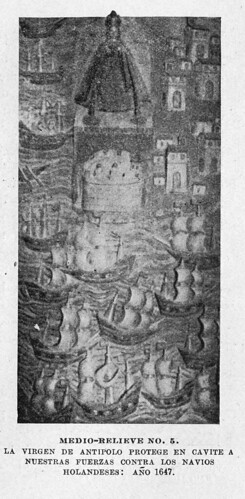
The Virgin of Antipolo protecting Cavite from the Dutch, 1647
Photo courtesy of Alex Castro.
Numerous are the legends about this image. The people firmly believe that Our Lady, preferring Antipolo to Manila and Cavite, several times abandoned these cities and was found installed in the flowery branches of the ' tipolo ' tree (Artocar- pus incisa), from which the town takes its name. To her are ascribed victories on the sea, the saving of lives and ships, and miracles countless."
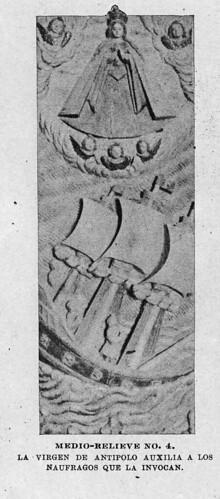
The Virgin of Antipolo, help of the stranded.
Photo courtesy of Alex Castro.





2 comments:
Wonderful account, Vic. Keep 'em coming.
Viva, La Virgen!
Post a Comment